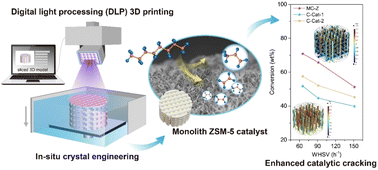In situ crystal engineering on 3D-printed woodpile scaffolds: a monolith catalyst with highly accessible active sites for enhanced catalytic cracking†
Abstract
Catalytic cracking of low-value oil fractions over ZSM-5 zeolites is a vital processing method for the manufacture of light olefins as critical building blocks in the petrochemical industry. Exploring novel zeolite engineering technologies that allow for better access to active sites and an optimized flow regime has long been one of the most important issues among scientific topics as well as in industrial practices. Herein, a monolith zeolitic catalyst with highly accessible active sites for enhanced catalytic cracking was fabricated by in situ crystal engineering on a digital light processing (DLP) 3D-printed woodpile scaffold. By anchoring crystal seeds onto the scaffold, a thick layer of ZSM-5 nanocrystals (ca. 60 μm) was in situ created on the monolith surface with the assistance of hydrothermal treatment, forming monolith zeolitic catalysts (MC-Z) with a high crystallinity of 41.2%. Such a high ZSM-5 loading on the 3D-printed scaffold surface enabled more acid sites to be accessible in catalytic reactions. In addition, a remarkable mass transfer advantage was revealed in the fabricated monolith zeolitic catalysts owing to their radial interconnected channels. The monolith zeolitic catalyst demonstrated superior activity in 1,3,5-triisopropylbenzene (TIPB) and n-octane cracking reactions. This strategy can be extended to other catalytic systems requiring highly accessible active sites to achieve further catalytic efficiency improvement as well as process intensification.



 Please wait while we load your content...
Please wait while we load your content...